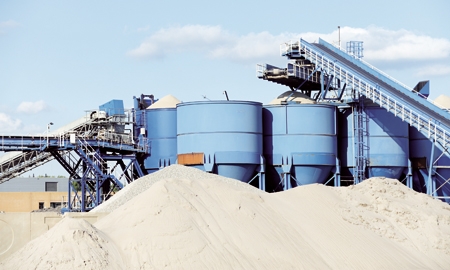In a country as busily engaged in large-scale development projects as Algeria, demand for cement is increasing faster than it can be produced and in recent years it has been necessary to import it to maintain the pace of construction.
Algeria currently produces around 18 million tons of cement per year. However, domestic demand is around 21 million tons, resulting in an annual cement deficit of approximately 3 million tons.
Demand for cement is particularly high in the dry season between March and August, which is the most favorable time for construction.
“We import to fill the deficit, but it is not a solution,” says Yahia Bachir, CEO of the
Algeria Cements Industry Group (
GICA), the state-owned cement producer. “Importing great quantities is sometimes impossible, because there is no availability even on the international market. The answer is to produce the cement ourselves.”
Groupe GICA has a $4 billion investment program spanning the next eight years that will boost its production of cement from 11.5 million tons a year to 29 million tons by 2020.
“The demand for cement is urgent and is increasing,
and we have to settle the deficit as soon as possible.” Yahia Bachir, CEO of Groupe GICA |
Created three years ago, Groupe GICA replaced the holding company SGP-GICA when Algeria decided to consolidate its state-owned cement companies and subsidiaries into a single giant industrial group controlling 12 of Algeria’s 14 cement factories.
The plan, according to former Industry and Investment Promotion Minister Hamid Temmar, was for the new group to become “a national leader for the cement industry and other building materials.”
Previously, the French private company Lafarge had dominated the domestic market, since acquiring Orascom Cement in 2008; Lafarge produces around 7 million tons of cement per year.
GICA’s aim was to increase the state’s share of the domestic market from around 67% to 75-80%, and later to expand its activities abroad.
Under the investment plan, cement-producing capacity will be raised by modernizing GICA’s existing plants and building new plants. Factories are planned in the northern province of Relizane and the southern provinces of Bechar, Adrar and Tamanrasset. Discussions are also under way with foreign partners for cement plants in Djelfa in north central Algeria and Sigus in the east.
“The process has already started,” says Mr. Bachir. “The demand for cement is urgent and is increasing, and we have to settle the deficit as soon as possible.
For that reason we have opted for the turnkey method of execution making a foreign partner responsible for realizing these projects. Not doing so would risk delay.”
The development program is expected to create 2,400 jobs. And as an additional bonus, cement produced in excess of demand can then be exported.
“We will certainly have excess once we achieve all our development programs; we estimate 4-5 million tons will be available for export in the next five years,” says GICA’s chief. “That is just the public sector. Taking into account the production of the private sector, Algeria will have an excess of around 10 million tons available for export.”
He says negotiations have already started with potential foreign partners who have the necessary experience and expertise in exporting cement.
“Cement is a product that is difficult to export. It is easily perishable; just a little humidity is enough to make it deteriorate,” he says. “We need to find partners that are used to selling cement internationally. In my opinion, we can do this kind of operation only with foreign partners who are used to such operations.”

0 COMMENTS